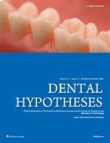فهرست مطالب
Dental Hypotheses
Volume:11 Issue: 1, Jan-Mar 2020
- تاریخ انتشار: 1399/02/18
- تعداد عناوین: 6
-
Pages 4-10Introduction
The aim of this study was to evaluate the effect of photo-activation methods on the shrinkage behavior of bulk-fill resin composites.
Materials and MethodsThree bulk-fill resin composites (Tetric N-Ceram bulk-fill, Xtra fill, and Filtek flowable) were compared in terms of polymerization shrinkage, shrinkage stress, and degree of conversion (DC). Two curing methods were used: 1) conventional and 2) soft-start curing. Five disk-shaped specimens of each bulk-fill composite were fabricated. The deflection disk method and custom-made linear variable differential transformer (LVDT) device evaluated the dimensional changes during polymerization. Universal testing machine was used to measure shrinkage stress. To evaluate DC, the absorbance peaks were obtained using Fourier Transformation Infrared Spectroscopy (FTIR). Data were analyzed by one-way ANOVA and Tukey test.
ResultsTetric N-Ceram bulk-fill (conventional mode) showed the highest polymerization shrinkage rate. Filtek flowable resin composite showed least amount of shrinkage stress and highest DC, while Xtra fill (with conventional curing) showed the highest shrinkage stress.
ConclusionPhoto-activation method had no effect on decreasing the polymerization shrinkage except for Tetric N-Ceram; also, polymerization shrinkage stress in Filtek flowable composites with both curing methods was less than other groups. DC was product dependent.
Keywords: Bulk-fill resin composite, degree of conversion, polymerization shrinkage, shrinkage stress -
Pages 11-15Introduction
The introduction of mineral trioxide aggregate (MTA) and bioceramic sealers increased the success rate of endodontic surgery and perforation repair. The aim of this study was to evaluate the marginal adaptation at different times of endosequence root repair material (ERMM) in order to evaluate its dimensional stability using variable pressure-scanning electron microscope (VP-SEM).
Material And MethodsFourty-eight teeth were selected shaped up to a master apical size of 25. Then a 3 mm cut perpendicular to the long axis and a retrograde cavity preparation were performed. In order to obtain 2 mm thick sample a second cut was done and, in this disk, ERMM was inserted. The samples were stored at 37°. The samples were divided into four time-depending groups observed with VP-SEM at time 0 (Group 1) and after 2 (Group 2), 7 (Group 3) and 30 days (Group 4) after ERRM setting. Statistical analysis with one way-ANOVA test was performed (95%).
ResultsNone of the four groups analyzed showed a complete marginal adaptation between dentin and ERRM. Instead, in all groups ERRM exhibited a completely preserved marginal adaptation to the dentin wall in all time-dependent groups. The mean (±SD) gap value was for time 0, 3.91 (±2.55)mm after 2 days, 4.32 (±2.69), after 7 days 4.49 (±2.53), and after 30 days 4.81 (±2.85)mm. No statistically significant difference was found between the four groups.
ConclusionsThe results of the present study demonstrate the dimensional stability over time of ERMM.
Keywords: Apicoectomy, dental marginal adaptation, electron scanning microscopy, endodontics, endosequence root repair material -
Pages 16-23Introduction
The articular eminence and condyle-fossa relationship reflects a secondary growth site and the morphology appears to be influenced by determinants of occlusal morphology which are subject to genetic variation of dentoalveolar bone metabolism.
The Hypothesisthe articular eminence of the TMJ inclination is a function of sagittal, vertical and transverse determinants of occlusal morphology and therefore it may be possible to influence modeling of the articular eminence with orthodontic treatment at least in a transient way.
Evaluation of the HypothesisThe morphology of the articular eminence, dentoalveolar bone remodeling rates associated with IL-Beta and determinants of occlusal morphology are considered with respect to the etiology of articular disc displacement and internal derangement of the temporomandibular joint
Keywords: Articular eminence, dentoalveolar, disc displacement, internal derangement, IL-Beta, occlusal, overbite, overjet, temporomandibular joint -
Pages 24-27Introduction
Previous research have established – in the problem solving of diagnosis and treatment of hard tissues defects, a significant role belongs to the choice of tactics treatment tooth destruction. This work aims to study the diagnosis problems and cavity classification, what will facilitate objectification of diagnostic and therapeutic approaches in the dental treatment of patients with this disease. For differential estimation of defects in teeth and for a precise assessment of the strength of the composition “tooth-restoration”, we conducted a mechanicmathematical modeling of contact interaction of restoration with tooth tissues. We also conducted anthropometric studies cavities all kinds and different groups of teeth.
The Hypothesis:
The first division of the cavities we have conducted in depth lesions: depth of destruction (DD). The next division we conducted on several parameters: Location of defects, Occlusion load, Volume of defects (LOV). As a result of the study, was proposed the cavity classification LOV/DD, is offered the method choice algorithm of treatment hard tissues defects, which is based on classification LOV/DD, and can serve as a selection criterion in the treatment of such pathologies.
Evaluation of the Hypothesis:
The proposed classification fills the obvious gap in academic representations of hard tissue defects, suggests the prospect of reaching a consensus on differentiated diagnostic and therapeutic approaches in the treatment of patients with this disease.
Keywords: Cavity classification, diagnostics, restoration, algorithm of treatment


